Ford Motor Company ended 2024 with strong fourth-quarter results. This shows its growth and financial strength. However, the performance of its EV segment fell short of expectations.
Given that electric vehicles are central to Ford’s net-zero strategy, this raises an important question: Is Ford falling behind in its sustainability goals? Let’s study the revenue report and its sustainability outlook in detail.
Ford Closes 2024 with Strong Fourth-Quarter Performance
Revenue surged to $48.2 billion, marking a $2.2 billion increase from the same quarter in 2023. The company reported a net income of $1.8 billion, with adjusted EBIT reaching $2.1 billion. Operating cash flow came in at $3.0 billion, while adjusted free cash flow stood at $0.7 billion, highlighting its steady financial footing.
For the full year, Ford’s revenue rose by 5% to $185 billion.
The company finished the year with over $28 billion in cash and nearly $47 billion in liquidity. This gives them flexibility in an unpredictable market. However, there was disappointment in the stock market as shares fell after the Q4 earnings release.
Ford’s President and CEO Jim Farley said,
“Ford is becoming a fundamentally stronger company. We finished 2024 with a solid fourth quarter, capping the highest revenue year in Ford’s history. Our product portfolio offers the broadest powertrain choice. And Ford Pro, with its mid-teen margins, leading market position, and growing service and repair revenue, provides unique advantages for continued growth.”
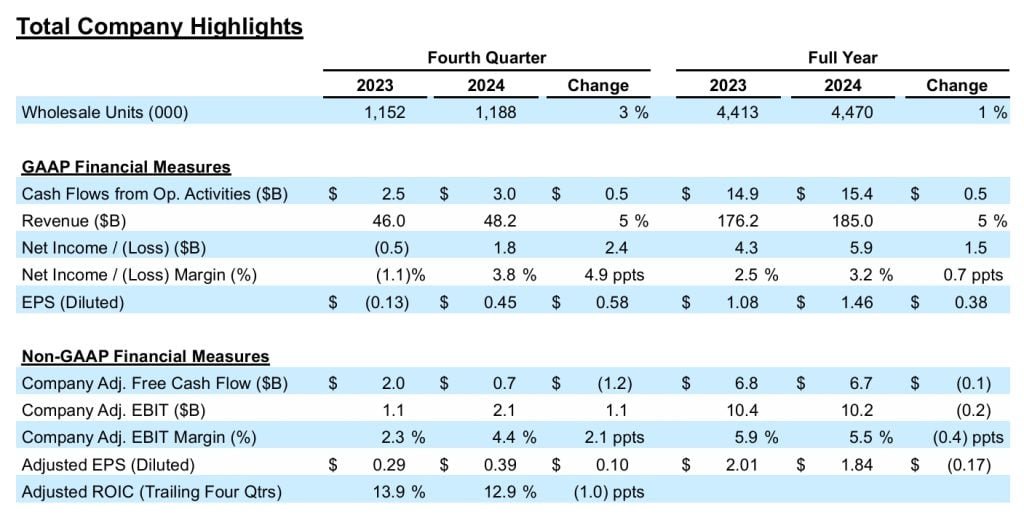
Ford Pro Excels, Ford EV Disappoints
Ford Pro performed well, with revenue increasing by 15% to $66.9 billion. It earned $9.0 billion in profits, achieving a solid 13.5% margin. Software subscriptions increased by 27%, hitting close to 650,000 users. Also, telematics usage nearly doubled.
In 2024, Ford Blue’s revenue stayed the same at $101.9 billion. Higher prices made up for a 2% drop in sales after cutting low-profit products. The segment earned $5.3 billion in profits.
Ford’s EV segment struggled, losing $1.4 billion in the fourth quarter and $5.1 billion for the year. Despite selling about 105,000 EVs, generating $3.9 billion in revenue, losses exceeded sales.
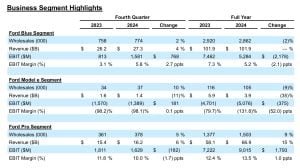
Ford’s 2025 Outlook: Modest Earnings and Cash Flow
Ford is expecting adjusted EBIT for 2025 to be between $7.0 billion and $8.5 billion, with adjusted free cash flow ranging from $3.5 billion to $4.5 billion. Capital spending is forecasted to be between $8.0 billion and $9.0 billion.
However, the company is preparing for some challenges due to market conditions. In the first quarter, Ford expects its adjusted EBIT to be nearly zero. This is because of lower sales, a less favorable product range, and ongoing launches at key U.S. plants like Kentucky Truck and Michigan Assembly.
Farley further added,
“In 2025, we expect to make significantly more progress on our two biggest areas of opportunity – quality and cost – as we enter the heart of our Ford+ transformation. We control those key profit drivers, and I am confident that we are on the right path to create long-term value for all our stakeholders.”
Ford’s Carbon Reduction Strategy for a Sustainable Future
Ford aims to cut greenhouse gas (GHG) emissions by boosting operational efficiency. Its Carbon Reduction Strategy aims to cut Scope 1 and 2 emissions by 76% by 2035, compared to 2017 levels.
- To track progress, Ford also set a shorter-term goal to reduce these emissions by 18% from 2017 levels by 2023, focusing on its manufacturing operations.
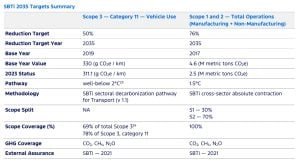
In 2023, Ford exceeded its target, achieving a 49% reduction in manufacturing emissions, and a total of 47% across all facilities. These efforts are helping Ford stay on track to meet its 2035 target.
- Additionally, its carbon-free electricity now accounts for 70.5% of its global manufacturing operations.
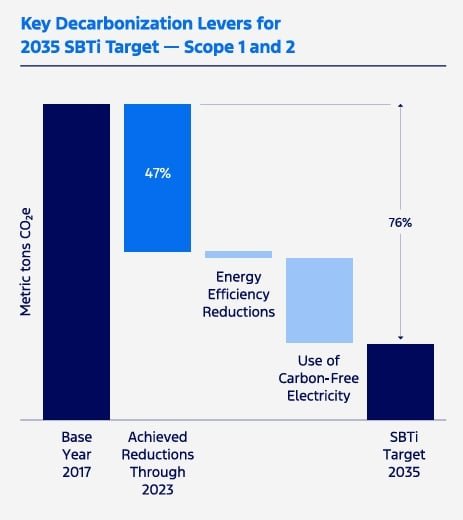
Fuel Efficiency and Emission Cuts in Ford’s Vehicle Portfolio
Ford’s vehicle portfolio is increasingly focused on models with the greatest potential for reducing emissions. The company is working on improving fuel efficiency for its light- and medium-duty trucks while also offering fully electric and hybrid versions of popular models. Simply put EV adoption is an important element of its long-term decarbonization strategy
- Data from the U.S. EPA shows that the real-world CO2 intensity of Ford’s light-duty vehicles in the U.S. improved by 21% for cars and 10% for trucks from 2017 to 2022.
One of Ford’s major projects includes developing hydrogen fuel cell technology for its medium- and heavy-duty vehicles. The company had partnered with the U.S. Department of Energy, to develop hydrogen fuel cell-powered Class-5 Super Duty trucks as part of the SuperTruck 3 program.
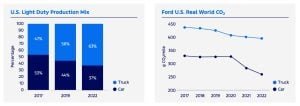
Ramping Up EV Production for Bigger Emissions Wins
Despite facing a drop in EV revenue, Ford would continue focusing on boosting its EV fleet. The plan includes battery-electric vehicles, hybrids, and fuel-efficient internal combustion engine (ICE) models. These options will help in areas where EV infrastructure is still growing.
- Ford highlights that driving a Ford EV, using average U.S. grid power can cut GHG emissions by up to 62% when compared to a similar ICE vehicle.
This reduction occurs for two main reasons: the energy used to charge the vehicle and the lower emissions than regular gasoline cars.
In 2023, Ford sold nearly 280,000 hybrid vehicles, marking a 20% increase from the previous year. This growth shows that hybrids are becoming more popular. They are a lower-carbon choice compared to traditional vehicles.
Looking ahead, the shift toward EVs is expected to lead to even greater GHG savings as the electric grid becomes cleaner. As EVs become more affordable compared to traditional vehicles, it will also boost Ford’s market share in the low-emissions automobile domain.
The post Ford’s Q4 Success Overshadowed by EV Losses— What About its Carbon Reduction Goals? appeared first on Carbon Credits.

